Editor’s Note: We are taking a brief break from putting together the book on the life and times of Admiral Mac Showers. I don’t think he will mind, since another old shipmate from the pacific Ocean Area has arrived at the Big Fleet Landing on his side of the Styx. I got the word last night from my sons, who informed me that my ex-father-in-law had passed. The Taps announcement goes like this:
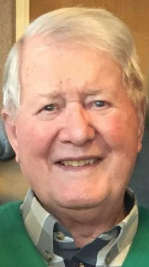
“Vincent W. Rohe, 95, of Medina went to his eternal rest on Saturday, November 26, 2016 at Medina Hospital surrounded by family. Vince was born September 28, 1921 to Vincent and Elizabeth (Lindhorst) Rohe in Cincinnati, attended Western Hills High School and the University of Cincinnati. He married Mary Geraldine (Connie) O’Connell, also of Cincinnati, in 1943 and was a decorated Navy combat pilot in the South Pacific during WWII. His squadron, VPB-116 flew patrol bombers (PB4Y/B-24) on anti-shipping and bombing missions. After the war, Vince went to work as an accountant. He and his wife raised six children in the Dayton area, and then later moved to Brecksville. A few years following his Connie’s death in 1991, Vince would later marry Viola Gearhart where they spent their retired life in Whispering Pines, NC. She survives.”
We worked on this story together fifteen years ago when I expressed an interest in his wartime experiences. The hook to the story is that his red Cocker Spaniel got 36 combat missions before returning to Ohio with his Skipper as the most decorated dog in the Sw Pacific. Rest in Peace, Vince. And for all the heroes who did so much so long ago.
– Vic
The Red Dog
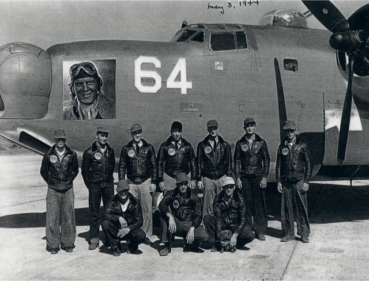
(This is Crew Nine, my family in the Pacific. The picture inset with the leather flying helmet and goggles is Skipper Vince of “Red Dog’s Playmate,” VPB-116. that is me down front when I was a very young pup.)
Truk dreams, where the Imperial fleet sleeps in the lagoon, now home only to fishes.
Keep cool, fool, it’s Rabaul…
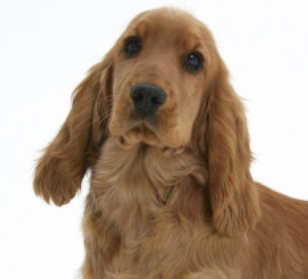
I am not going to be modest about it. What is the point in that? I one of the most decorated dogs in the Pacific Theater. My name is Red Dog, and I came about it through luck, mostly, and by having a good crew. I took pretty good care of my boys, if I do say so myself.
Skipper Vince is a kind hearted guy from back east in Ohio, round the Cincinnati area. Kind hearted, for sure, but tough as nails if you were not performing to his standard. He was a little older than most of the guys. He had a wife and they lived on Coronado Island while they were in training.
I am a $50 dollar dog. That is what Skipper Vince paid for me. A lot of people told him that was an outlandish price to pay for a little puppy, but I like to remind folks that I have a pedigree, and am one of the finest Cocker’s to serve in the U.S. Navy. Skipper Vince has excellent taste. I was the pick of the litter. I was picked on the basis of my superb color and my excellent voice. That’s what Vince says, anyway. And I am a San Diego Dog, with all of those extraordinary qualities. We tend to be pretty relaxed dogs, quality barkers, of course, but the superb climate has given us a certain mellow quality. One of the first memories I have is of looking up at the big bulk of Point Loma, where they had turned off the big lantern on the lighthouse in case the Japanese attacked.
I suppose I should start at the beginning. By breed, I am a Cocker Spaniel, and darn proud of it. Like many dogs of my generation, I was called to serve in the great conflict that swept over the entire globe. You have no idea today just how big this thing was. All of Europe was either conquered by the Germans, or fighting with them. Our pals, the Russians, had their backs up against the wall and it looked pretty grim. The Brits were holding on by a thread, London burning from the bomber raids that Adolf Hitler ordered. The kids in San Diego had a little rhyme they used to sing that went along to the Walt Disney ditty from Snow White:
“Whistle while you work,
Hitler is a jerk,
Mussolini
Bit his weinie,
Now it doesn’t work.”
I have a keen interest in tennis balls and geopolitics. It pays off in wartime to know what is gong on around you, and trust me, my floppy ears perked up about things that could get Crew 9 in trouble. Mussolini was a dictator in Italy, I understood, a sort of junior partner in evil to Hitler, I was told. He had thought up a lot of what Hitler put into practice, but Hitler applied German thoroughness to it all. America wasn’t in the war yet, not until December of 1941, but we all knew it was coming. Something was in the air.
Our problem of the moment was in supplying our friends the Brits and the Russians with trucks and ships so they could keep on fighting the Germans. So even though we weren’t fighting, we had plenty of good American kids and their mascots serving on ships that went to sea and got torpedoed by the German submarines. By the time I was born, in 1941, the war against the Nazis had spilled over into North Africa and was headed for the Middle East. All that remained was for something to happen in the Pacific and it would be truly global, the biggest thing that ever happened. So I’m proud to say I’m a veteran, but everyone did something. This was the first time they let women work in the factories, and it was what eventually caused a lot of very good things to happen to a very good country. But we had a saying for it then, human and dog. We were in it “for the duration.” Until it was over.
Skipper Vince had signed up for the Navy in 1941, before the war broke out. He wanted to be ready to go. He had done all his pre-flight training and before Red Dog’s Playmate was assigned to be our airplane. It was a big hulking monster of a bomber. This one had a boring Navy name- they called it ‘Bureau Number 38777,’ which meant it was a J-model PB4-Y1 “Liberator.” I have been very lucky to be one of the foremost canine authorities on aviation matters.
The Navy has bought the four engine monster after our cousins the Brits had success with it against the Nazi U-Boats. I don’t know what sort of dogs flew in those. I suppose it was probably bulldogs, since that is what I always pictured Mr. Churchill to look like. The war had been going on for nearly a year when the Navy made the decision. Skipper Vince was doing training at Coronado and up in the hills at Camp Kearny. It was the fourth series of airplanes to be bought by the Navy,
The airplane was massive on the outside, but oddly tiny on the inside- more my sized. The guys would always be bumping their heads on the sharp metal angles. The liberator was not designed for comfort. It was designed to haul people and bombs a long way and drop them on something. Not the people, anyway, and when the bomb-bays were open I had to be careful it wasn’t me!
The plane was powered by four giant Pratt & Whitney R-1830-43 engines, each with a four-bladed propeller. The Liberator could fly nearly two thousand miles on one load of fuel and with a full load of bombs. That is a long way. And the Liberator’s would bring you home, as my crew used to say, and I appreciated that since I really had to take a walk- if you know what I mean- when we got back. It had some firepower, and when the crew was testing the weapons I had to burrow under a pile of parachutes to protect my sensitive hearing. There were twelve .50 caliber machine guns, two up front with the nose-gunner, two in the tail, two on each side in blisters on the side of the airplane, and four along the spine, two just in back of Skipper Vince and another two just above the waist-gunners. We carried nearly 7,000 rounds of ammunition for the guns, and it was all linked together and run through little conveyer belts.
Along the way, I learned we could carry up to four 2,000 pound bombs, or twelve 500 pounders or mines of depth charges, depending on what the mission was.
PB4-Y2’s were coming out of the plant at the Consolidated Vultee plant next to Lindberg Field in San Diego.
The Official Name of BuNo 38777 was “Liberator,” which is what it was intended to do. It carried a crew of eleven young men and one small red dog. Red Dog’s Playmate, which featured a painting of a cute cocker spaniel on the nose. I thought it was very tasteful. And painted under the picture was the name of the airplane: Red Dog’s Playmate. You could tell the guys kinda idolized me.
By the time I was nearly three, this is what the crew looked like. The kids in the crew averaged 19 years of age. Skipper Vince was the old man at 21. Back home, their folks would think twice about giving the crewmen the keys to the family car. And now the Navy was handing them a four-engine bomber and telling them to go off and fly thousands of miles and fight in a war. These were great kids. The Skipper and my special pal was Lieutenant Vince “Pappy” Rohe (76 in green ink). Our mechanics were Eddie “Hammer” Hammister- First Mechanic, and Bill “Chew” Beechnau- Second Mechanic. He got that nickname from the Beechnut chewing gum he used to chew. And he would always park his gum under his machine gun.
Eddie “Birdman” Thrush was the First Radio, and “Mac” McKeon was second. Norman “Ball” Hoops was our tail-gunner, and Bob “Chiclets” Hansen was our nose gunner. He had almost the best view in the airplane out of his armored turret. Skipper Vince had a pretty good one, but the windscreen he looked out of didn’t let you see much except out and forward over the nose. Sometimes it was better that way, the Skipper used to say. Larry “Action” Jackson was our maintenance man and lead armorer, the guy who would arm the bombs once we got airborne, and make sure the fuse wires were rigged and ready to be pulled out. The wires kept the little propellers on the tips of the bombs from turning around until the bomb actually left the airplane.
The turns of the propellers are what cause the bombs to arm. You don’t want that to happen inside the airplane. Archibald “Skinny” MacLean was Action’s helper and second maintenance. Al Shafer and Don Kircherg were the other officers. Shafer was the navigator and Kircherg was the other aircraft commander that flew with us sometimes. But it was Skipper Vince’s show, just like it was his call to being me along as the Crew Nine Official Mascot.
Crew 10 was lead by LT Chuck Scranton, and another LT named Tubbs and some other fellows. They were not my Crew, but I did not mind playing with them if they were awake and wanted to throw a ball.
San Diego
Skipper Vince was introduced to a strange beverage called a “Stinger.” I guess that called it that because after a while it seemed to make him feel like he had been bitten by a bee or something. The guys were playing a card game called bridge, and they played in a very animated way, yelling things like “No Trump!” and somebody was called the Dummy but no one seemed to mind. After a while Skipper Vince went off to the Head, which is what they called the bathroom. In the old Navy the crew had to climb way up forward to use the facilities, and they called that part of the sailing ship the “Head.” So that is Navy guys call the bathroom even today. Army guys call it a latrine, but I am not an Army dog and I can’t tell you why. Vince was leaning on the sink and he looked sort of green, I don’t know why about that either but it might have had something to do with the Stingers. He looked so ill that it got me going, too. I might have had too much steak for dinner, because the crew used to pass down scraps off their plates. I accidentally threw up on Vince’s show.
When we go on a Mission, I always like to find a spot on a parachute bag under Thrush’s feet in the radio compartment. He is the radar and radio operator on Crew Nine. He gets scared sometimes and it is my job to keep him calm so he can do his job. There is a heat vent there, and the warm air and the vibration from the four big prop engines make it a cozy place to rest. It is a long time on a Mission. Sometimes we are gone for ten or twelve hours. I can’t tell exactly, because I can’t wear a watch. I listen when Lieutenant Vince- the Skipper- calls down for a time check just before the takeoff roll.
Skipper Vince clears his throat and then keys the microphone to talk to the Tower. “Red Dog’s Playmate at threshold. Ready to roll.”
“Roger Red Dog. Cleared for takeoff” comes crackles the radio. Then the Skipper and Lieutenant Kirchberg reach down between them and push the throttles forward. The skipper releases the brake pedal, and the big airplane starts to move, first slowly and then faster and faster until the heavy tropical air begins to lift the nose wheel off the ground.
The plane picks up speed. “OK” calls the Skipper, “I think we’re going flying.” He begins to pull back on the yolk gently and the nose begins to come up. We roll for a while longer, since the airplane is heavy with fuel and bombs. Then the wings tip slightly from side to side and the main mount tires begin to hop along the runway.
I am confident that we are going to get airborne. My combat station is in a box on top of a flight jacket between the Chiclet and Chew, the gunners in the waist of the airplane.
Chew also is the ball-turret gunner, He will not crawl down into the turret on this long flight because we do not think there are any Japanese between us and Hawaii. The briefing officer had seemed pretty confident on that score, and he crawls down into the belly turret. It was a power turret with a little door in the back. He operated it with little pedals and would turn every which way. It was kind of scary, though, and I didn’t like to see him go down there because if the Japanese shot at us and we lost power, he was going to be stuck in there. And if the landing gear didn’t come down, then he was going to get scraped off the bottom of the airplane. So I was always relieved when the turret door came open and he got out of it. I would snuggle up to him and let him scratch my head behind the ears. It seemed to make him relax.
Vince flew west with Crew Nine from Camp Kearny to NAS Kaneohe on the North Shore of Oahu. It is the prettiest base in the world. The mountains nestle it. The bay is azure. The palms hang languid or dance in the sea breeze in the afternoon. A little atoll like a Chinaman’s hat sticks out at the end of the peninsula. Everything moves slowly here, cut off from the hustle of Honolulu. Tranquil, it’s peace was only marred once by the Japanese, who visited here twice on the morning of December seventh, 1941. They left K-Bay in smoking wreckage.
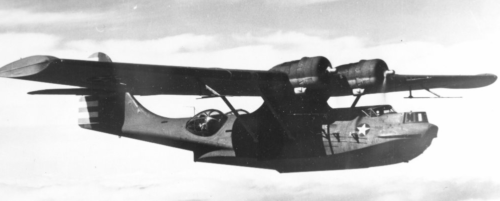
Skipper Vince trained first on what they called P-boats, the PBY-5 flying boats. Full stall landings, dig in the after part of the hull and then let the boat flop down. It was tough on the engineer, who sat up high.
They flew from Camp Kearny, to K-bay, flying on a beacon from a Navy Destroyer Escort, station in the vastness to broadcast a signal to keep them on track on the fourteen hour flight, lumbering on the four Pratt and Whitney engines.
One of the other crews lost an engine on take-off, the mighty prop seizing, then feathered. The airplane was heavy with fuel for the long flight, and the skipper tried to bring it back too soon. Crew eight didn’t wait long enough, and they crashed and all of them died. K-Bay thought that it was the Red Dog’s crew that had crashed, because they took off right after them. So maybe after that, having died once, Crew nine got a free pass.
Then the Skipper took training on radar flying. Another crew was lost at low altitude in the channel between Ohau and Molokai, where the current runs swiftly. They all lived, the patrol plane breaking apart at the nose and the waist, deposited the surprised crew into the chilly water exactly like it was planned that way.
There had been a meeting back in Washington. I heard Skipper Vince talk about it. All the Navy guys were interested. They had all the scuttlebutt. That’s an old Navy term, and all of us in the Navy are proud of our special language. It makes us special. A scuttlebutt is a drinking fountain now, but in the olden days it was a barrel with drinking water where shipmates could gather and gossip. The President was there, of course, and Prime Minister Churchill came across the Atlantic to talk about what they were going to do about this global war. There was fighting everywhere, and the Japanese looked like they were going to overrun the entire Pacific, maybe invade Hawaii or even land in California. That got my dander up as a San Diego dog. We couldn’t stand the idea of that.
Eniwetok
Then, following Operation GALVANIC, we landed in the Marshall Islands at Eniwetok for combat sorties to a variety of places, to include Wake Island, where the sailors and civilians had held on against the invaders and been humiliated in captivity.
Eniwetok is what the old Micronesian navigators called the ‘Land Between the East and the West.’ They would stop in their long canoes to rest on the dozens of little islets that make up the Atoll. As a good San Diego canine, I prefer tofly in things with four engines.
Engebi is the northernmost point on the atoll- that is where the Marines first landed. I have a special fondness for the Leathernecks, which are proud of their nickname “The Devil Dogs.” We have to stick together. Captured documents indicated a large force of Japanese were dug in on the southernmost island in the chain there, and on Parry island, the next biggest to the North. The marines stormed ashore on 17 February, 1944.
They didn’t always fly missions, and sometimes the waiting around was enough to drive us crazy under the tropical sun. Sometimes I just had to find the shade under a cot and loll there, tongue out, waiting for someone to give me a decent rub on the head, or my belly if I had enough energy to roll over for it.
Vince and Crew Nine decided to form a yacht club. There were a couple belly tanks from an F6F Hellcat down by the landing strip. The Hellcat was a carrier-based airplane, and someone had to dump them here before going back to the mighty Enterprise, the Big E. Thy called the aircraft carriers bird-farms, or flat tops. There was always a good-natured rivalry between the carrier pilots and the land-based patrol crews. Vince and Al thought about the tanks for a while and came up with a plan. They horsed the things down to the beach and found some scrap wood planks that had come from packing crates for replacement engines. They connected the tanks and conned a SeaBee into rigging a heavy metal rudder.
SeaBees were the most useful fellows imaginable. They seemed to have all the food and those little round cans the Crew was so found of. Their SeeBees name came from the initials “CB,” which stood for Construction Battalion. They landed just in back of the Marines, and when the leathernecks were done shooting, and sometimes before, they were getting things ready for airplanes to land. Setting up the camps and the fuel dumps and all the other things that made these little islands lost in the vast Pacific so vital to the war.
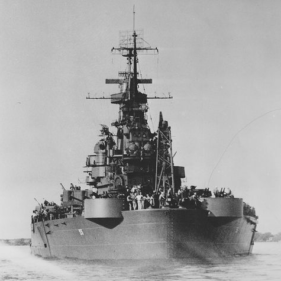
Vince found a long piece of aluminum tube that worked pretty well for a mast, and a discarded parachute made a perfectly serviceable sail. They found a fifteen pound chunk of coral for an anchor, and started the Eniwetok Yacht Club. One afternoon the fleet was in, doing voyage repairs and getting ready to go out and engage the Imperial Fleet. The great hulls of the battleships were painted in strange zig-zag patterns to confuse the Japanese submarine captains. The mighty USS North Carolina was nestled in with heavy cruisers and escort destroyers in the lagoon. She was one heck of an imposing ship, I will tell you! I yipped in surprise when I first saw it from the beach.
Vince and Crew Nine scooted away from the beach at Eniwetok in their improvised sailboats, and began darting in and out of the big warships. Sailors raced to the railing to get a look at something they hadn’t seen in a long time- a dog with his nose in the air, and his people relaxing and having fun.
Yachting was a splendid was to pass the time, and it was great for a couple weeks amusement. But then one night a big storm blew up, one of those oceanic happenings that makes the low little sand-and-coral islets nearly submerge. One of the other crews that was on patrol duty that morning saw the sailboat broken up and washed ashore on Parry Island, the next big island in the chain to the northeast. And that was the end of the yacht club.
On Eniwetok, they got two beers each, and would bury them in the sand near the surf’s edge in 20mm ammunition canisters on ice. Then they would go to the theater, a big open-air thing with benches and some big bed-sheets stitched together for a projection screen. When the movie was done, they came out and dug them up, icy cold, or at least colder than the humid tropical air.
The Skipper always made us laugh when he wasn’t telling us what to do for our own good. He had a sign that hung in front of his tent all over the Pacific that read: ‘The Honeymoon Lodge.’ It always startled the new men reporting to the Squadron, and they laughed at the idea of seeing all the way in the Southwest Pacific!
Crumbs and Ants- Christmas.
Skipper Vince got lucky at one mail-call. He got a package that had a can containing a fruitcake. They rigged it to the roof so the voracious insects on the island couldn’t get at it, and they fortified the cake with what booze they could get, hoping to make it very merry come that Christmas day. But the ants were having none of that. They marched up the side of the tent, and along the ridge-line to the peak, and then through a small hole, and then down the rope and into an equally tiny hole in the can. And crumb by crumb, the ants staggered back up the string and out through the hole and down the side of the tent and when Christmas came, the can was empty.
Somewhere Skipper Vince broke his nose, and we flew out of a place called Marcus Island, which I did not care for since there were too many rats for my taste and you can only chase so many, you know?
Tinian
Tinian is a little tear-drop-shaped island south of the Saipan Channel from the larger island of Saipan. It is part of what Crew Nine taught me was an ‘archipelago.’ I am probably the best qualified expert canine in the whole Pacific Ocean Area, which is what they called the combat theater, and I will be so bold as to say am a gifted canine geographer now. The southern and largest island in the chain is called Guam. On the eighth day after the invasion, they landed on the Japanese fighter strip on the north side of Tinian Island. There were still snipers in the trees and real combat troops still mopping up the stragglers. They flew from Tinian against Palau, and the Philippines. Then up the slot to bomb Iwo Jima. They even made a mission against the Gibraltar of the Pacific, Rabaul, where the artillery bristled and the flack blossomed in orange and black. They were with another crew commanded by Leif Erickson, who as a strikingly handsome man who told Skipper Vince he had aspirations to be a movie star if he lived through the war.
Keep cool fool, its Rabaul.
One day the Skipper told us we had a mission to the big Japanese naval base at Rabaul. They thought it was an impregnable target, and the Navy made Red Dog’s Playmate available to take an Army photographer along, who later became famous. They flew at 4,500 ft. The photographer, wanted to know how long he would have to film, and how many passes he could count on. Skipper Vince told him “One. And fast.”
Later the Sea Bees were working around the clock to finish the strip at West Field.
On Tinian, the shower was made from an eight-man raft, leaned up against the tent. Four man tent, same of the officers and the enlisted, on flat coral. The Seabees did it. The rainwater would pour from the roof of the tent through a sluice formed by the raft. I would walk over there to watch the horseplay that would develop.
The humans really liked to get a nice shower periodically, though myself I can take or leave them. The thing that made the men cranky was that they could only shower when it rained.
I slept with the officers in The Honeymoon Lodge, since they had more room, better covers and such.
The North Field was 5200 feet in length, plenty big for the Japanese Zekes, but way short for the big patrol bombers. It was tight getting in and out of there. The Sea Bees
It would have been like going to camp, the crew said, if it were not so deadly serious. The crew was quite creative about making our little square of sand and coral into a home.
There were helmets mounted on a wagon wheel mounted horizontally on a post for shaving. The contraction made the wheel into a big Lazy Susan at the Honeymoon lodge so the boys could turn it around to rinse their razors and wash their faces. That is where the Honeymoon Lodge gang Crew Nine watered and shaved.
I would help by trotting along with the armed guards to get water. They had to have an escort because the Japanese snipers would go after the crew when they went to the well to get drinking water. The Japanese would fly in and sprinkle twenty-pound bomblettes, nasty little things if they got close, with streamers attached gaily to the fins.
Skipper Vince said it was just harassment, but deadly sometimes. Vince had the duty one night and I went along to keep him company. They had detected Japanese planes on the radar. It came from Saipan to ruin their sleep. One was famous on Guadalcanal. It was a two-engine plane and the engines were horribly mis-tuned. It sounded like an overloaded washing machine. The pilots called it Washing Machine Charlie. Skipper Vince called the Commanding Officer. “What do you want me to do?” as the bombs came down.
“Duck!”
Vince wound up in the ditch, in the mud and the slime in his uniform.
Chuck Scranton was leading a thirsty party to the well one day. They came upon a water buffalo, placidly gazing at them. His world had been overcome by thunder from the naval artillery and the storming of the beaches by the Marines, the shouting and explosions. And now he was taken prisoner by Crew Nine and me, the Red Dog. They loaded their water jugs onto the cart and lead the buffalo back to the north field and the tents.
The Commanding Officer about blew a gasket. “No One is entitled to a personal water buffalo for transportation!” I was OK with that, since in my experience water buffalo are not very bright and can step on vertically-challenged cocker spaniels.
The existing field was in adequate, so the Sea Bees expanded the strip to nearly 10,00 feet. That was the strip that the Enola Gay used later to end the war. I was very happy about that. I like the tropics and everything, but the war was not that much fun for a dog, and I am pretty sure Crew Nine felt the same way.
On Tinian, the latrines were as inadequate as the runway. There was a powerful smell that bothered the crew, but you can imagine the impact on a dog’s sensitive nose for me. To keep the smell down they would pour lye and ignite the waste. Some guys who were using the facility would run out of there with big back circles on their butts. I offered to sniff them for them but they were pretty cranky.
Then the Philippine Islands: Skipper Vince read the names at the big crew brief before we took off. “Tacloban,” he said. “ Samar, Leyte Gulf.”
The days blurred together and the final campaign to the north began.
Flying to Okinawa, with Kamikazis.
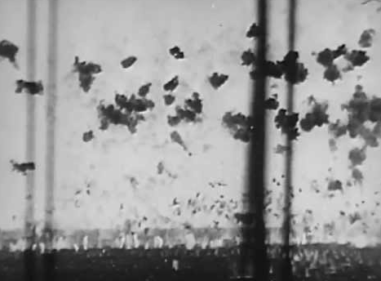
I am not very good at reading calenders, but the Skipper said the 3rd of April, 1945 was a red letter day. We had done the number of combat missions to qualify for rotation, since the Navy knew that if they made the crews keep flying for the duration of the war, eventually they would be killed. It was just the averages. The replacement crew shows up at Iwo, the CBs scrambling to lengthen the runway for emergency landings for airplanes shot up over the home islands. I would wait by the tower to watch them stram back in, shooting flares if they had wounded aboard to ensure the doctors and the brand-new Navy Nurses would greet them as soon as they were on the ground.
Lieutenant Fitzell is the new Skipper’s name. Vince is pretty pleased to see him so he can go home. Skipper Vince is going to take me back home to Cleveland. I don’t know if I will like it. After all, I have been a California and tropical dog my whole life. But I would do anything to stay with Skipper Vince. He is the greatest.
We flew the bomber named for me back east across the Pacific. Half way to the West Coast was John Rogers Field, later Honolulu International. We were carrying a cargo of white mice for the Research Hospital. The weather was terrible, and the Skipper took us up to 15,000 feet to avoid the turbulence. That is where the crew would have to put on their oxygen masks, and Al the gunner would periodically lean down and let me breath from his.
We got on the ground in Honolulu and the Loadmaster came out to inventory the cargo.
“Where are the mice?” he asked. “I don’t see any mice?”
“Oh,” said Vince, realizing what had happened. “I guess they didn’t have those tiny-mouse sized ones to send with us back on Iwo Jima.”
Home
Skipper Vince found a Navy officer to take receipt for the bomber, and we were just passengers again. We flew with Navy Air Transport squadron VR-11 for the trip to San Francisco, and then an assortment of airplanes back to Cleveland.
As it turns out, Cleveland was just fine, and I highly recommend the quality of their squirrels. I have seen no snipers whatsoever, and all my walks with Skipper Vince have been peaceful except for the squirrels.
I never saw most of Crew Nine again, but I wanted to try extra hard to remember their names:
Crew members:
Lt Vince Rohe (76 missions in green ink- that means combat.)
Hammister- First Mechanic
Beechnau- Second Mechanic
Thrush- First Radio
McKeon- Second Radio
Norman Hoops- Tail Gunner
Hansen- Nose Gunner
Jackson- Maintenance
McLean- Maintenance (Armorers)
Al Schafer
Don Kircherg, Patrol Plane Commander
And of course there was me, the Red Dog, the thirty-six green ink combat mission canine.
Copyright 2016 Vic Socotra
www.vicsocotra.com
